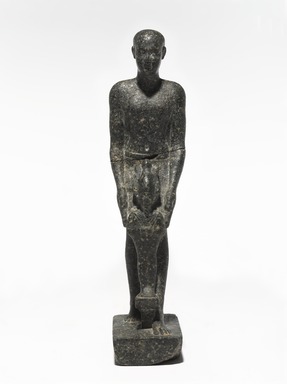
Medium: Granite
Geograhical Locations:
Dates:ca. 399-381 B.C.E.
Dimensions: 7 1/2 × 1 3/4 × 2 3/4 in., 1 lb. (19.1 × 4.4 × 7 cm, 0.45kg)
Collections:
Exhibitions:
Accession Number: 77.50
Image: 77.50_PS9.jpg,
Catalogue Description: One mottled green granite (with flecks of white and black) statuette of a male figure offering an image of Osiris. The figure is striding and wears only a striated kilt, which is belted but uninscribed. The mummiform image of Osiris wears a false beard attached under the chin and a white crown flanked by two plumes. There is a uraeus on the crown. The hands of the Osiris are positioned knuckles to knuckles and each holds a hoe. Osiris stands on a pedestal which abuts the instep of the advanced left leg of the owner. The figure’s torso modeling is ample with soft pectoral forms. His head is completely shaved, his lips pursed, and the cosmetic lines of the eye brows are visible. The back pillar is inscribed with a single column of hieroglyphs, each sign is carefully incised and there is an absence of crowding. The top of the back pillar is in the shape of a triangle and the rear surface extends from top to bottom in one plane. The top of the back pillar is on the level of the mid-forehead, above the eyes. The base of the statue is rectangular in shape. Perfect state of preservation. This statuette is in remarkably fine state of preservation and contains a complete and neatly carved hieroglyphic inscription on the back pillar, naming the owner, Hor, and tracing his family back for three generation. Condition: The statue was once broken in two halves but is restored break to break in the area of the belt. Minor chips are missing from the joints of the forearms and lower arms. There is also a chip missing from the belt. Large diagonal chips are missing from the base's left front and left rear corner. In addition, there are chips missing in other areas of the base but these are negligible.